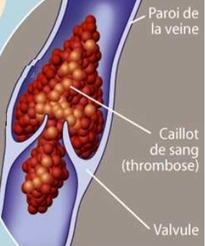* Phlebitis is deep vein thrombosis; in the lower limb, it is constantly occlusive.
* Some medical causes cirrhosis (antithrombin III deficiency, protein C or S). Lupus (antiphospholipid syndrome, lupus anticoagulant) Behcet’s disease; hiatal hernia and uterine fibroids with bleeding Minimum => hypercoagulable state.
* Placard sign: high temperature and pulse.
* Diagnostic strategy: it takes into account the clinical probability of phlebitis and uses two diagnostic tests: Venous ultrasonography and measurement of D-dimer.
* The fundamental sign sought by the Doppler ultrasound is the loss of compressibility. This exam is especially effective for femoral and popliteal thrombosis.
* The measurement of D-dimer is by ELISA; this test at a very high negative predictive value.
* The venography can be done in case of discrepancy between positive and negative D-dimer Ultrasound
* Phlematia alba dolens: this late stage of the evolutionary phlebitis; general signs are constant (high fever, leukocytosis, VS ++). Local signs are major (white swelling, hard, hot, deformed leg, not pitting).
Total functional impairment.
* Phlegmasia coerulea: sudden onset, flu-embolic, it combines phlebitis arterial ischemia by arterial compression due to edema or no spasm. It complicates phlebitis haires (iliofemoral) the member is oedematous, cold, cyanotic and peripheral pulses are absent. Pulmonary embolism are common.
* In case of superficial phlebitis treatment is only local (NSAIDs).
* Parade Syndrome costoclavicular => phlebitis of the upper limb.
* LMWH is the cure benchmark emergency (100 IU / Kg morning and evening if Lovenox)
* The vitamin K are begun are started from day to keep the average duration of heparin therapy and prevent thrombocytopenia. (Duration: minimum 3 months
* LMWH is stopped when the INR is between 2 and 3.
* Thrombolysis is a possible indication of phlegmasia coerulea.
* Partial obstruction of the vena cava filter by -> discuss if extensive proximal thrombosis with floating clot despite adequate treatment; recurrent pulmonary embolism despite adequate treatment; of recurrent pulmonary embolism;or pulmonary embolism with against-indication to anticoagulant treatment.


Leave a Reply